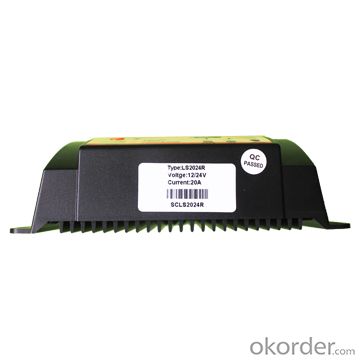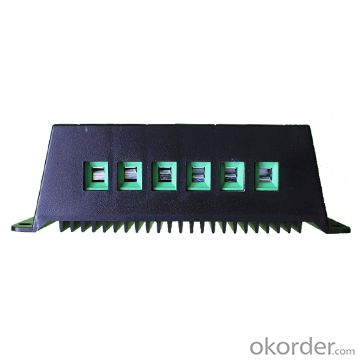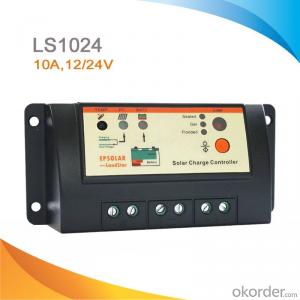PWM Solar Charge Controller with Power Switch for Solar Home System,10A ,12/24V LS1024
OKorder Service Pledge
OKorder Financial Service
You Might Also Like
Solar Charge Controller Descriptions:
LandStar series solar charge controller is a new generation lighting controller for off-grid solar system, such as home system, traffic system, CCTV system. It adopts the most advanced digital technique and operates fully automatically.

Features:
12V/24V automatic identify or user-defined working voltage.
With functions of current power calculation, it is convenient to view charging and discharging energy of each day, month, year and total value.
Wide input voltage range: DC8.0V---DC32V, compatible with 12V/24/ full voltage range.
Digital precision constant current control and the control accuracy are better than 2%
Maximum output efficiency of 95%
The rated output current can be adjusted at rated power and current range.
The max current output voltage can reach up to 60V
Charge control parameter, the load control parameter and the output current value can be set separately
Use standard Modbus communication protocol for TTL232 bus connection, communication protocol compatibility much better.
Fully encapsulated PCB, IP67 protection
Aluminum housing
Electronic Protections:
·Overheating
·Over discharging
·Over charging
·Load overload
·Load short circuit
·PV short circuit
·PV reverse polarity
·Battery reverse polarity
Specification:
Electrical parameters | LS1024 | LS2024 |
Nominal System Voltage | 12 / 24VDC auto work | |
Rated Battery Current | 10A | 20A |
Max. Battery Voltage | 32V | |
Charge Circuit Voltage Drop | ≤0.26V | |
Discharge Circuit Voltage Drop | ≤0.15V | |
Self-consumption | ≤6mA | |
Overall dimension | 140 x 65 x 34mm | 144 x 75x 45mm |
Terminal | 4mm2 | 10mm2 |
Net weight | 0.15kg | 0.25kg |
Working temperature | -35℃ to +55℃ | |
Humidity | 10%-90% NC | |
Enclosure | IP30 | |
Battery Voltage Parameters (temperature at 25℃) | |||
Battery charging setting | Gel | Sealed | Flooded |
Equalize Charging Voltage | —— | 14.6V;x2/24V | 14.8V;x2/24V |
Boost Charging Voltage | 14.2V;x2/24V | 14.4V;x2/24V | 14.6V;x2/24V |
Float Charging Voltage | 13.8V;x2/24V | 13.8V;x2/24V | 13.8V;x2/24V |
Low Voltage Reconnect Voltage | 12.6V;x2/24V | 12.6V;x2/24V | 12.6V;x2/24V |
Low Voltage Disconnect Voltage | 11.1V;x2/24V | 11.1V;x2/24V | 11.1V;x2/24V |
Equalize Duration | —— | 2 hours | 2 hours |
Boost Duration | 2 hours | 2 hours | 2 hours |


- Q:Can a PWM solar controller be used with an MPPT solar panel?
- No, a PWM solar controller cannot be used with an MPPT solar panel. These two technologies are not compatible as they have different operating principles. PWM (Pulse Width Modulation) solar controllers regulate the voltage output from the solar panel by rapidly switching the panel's current on and off, resulting in a fixed voltage output. On the other hand, MPPT (Maximum Power Point Tracking) solar panels utilize advanced electronics to optimize the power output by continuously adjusting the voltage and current levels to extract maximum energy from the solar panel. Therefore, to maximize the efficiency and performance, it is recommended to use an MPPT solar controller with an MPPT solar panel.
- Q:What is the maximum load power consumption in standby mode of a solar controller?
- Depending on the specific model and manufacturer, the maximum load power consumption in standby mode of a solar controller can vary. However, it generally remains quite low, typically ranging from a few milliwatts to a few watts. This minimal power consumption is crucial for minimizing energy waste and ensuring the efficient functioning of the solar controller. By maintaining a low load power consumption during standby mode, the solar controller can preserve energy and prolong the system's overall lifespan.
- Q:How does a solar controller handle battery under-voltage protection?
- A solar controller handles battery under-voltage protection by continuously monitoring the voltage level of the battery. If the voltage drops below a certain threshold, indicating that the battery is being discharged too much, the controller will automatically disconnect the solar panels from the battery to prevent further depletion. This protects the battery from irreversible damage and prolongs its lifespan.
- Q:Can a solar controller be used in a solar-powered cooling system?
- Yes, a solar controller can be used in a solar-powered cooling system. A solar controller is responsible for regulating the charge of the batteries in a solar power system, and in a solar-powered cooling system, it can help control the power supply to the cooling components. This ensures efficient use of solar energy and proper functioning of the cooling system.
- Q:Can a solar controller be used with a solar-powered religious institution?
- Yes, a solar controller can be used with a solar-powered religious institution. A solar controller is an essential component of a solar power system as it regulates the flow of electricity between the solar panels and the batteries, ensuring optimum charging and preventing overcharging. It is crucial for maintaining the efficiency and longevity of the system, regardless of the purpose or nature of the institution it powers, including religious institutions.
- Q:What is the maximum charging current of a solar controller?
- The maximum charging current of a solar controller depends on the specific model and its design specifications. It can range from a few amps to several hundred amps, depending on the size and capacity of the solar controller.
- Q:Can a solar controller be used with solar-powered air pollution monitoring stations?
- Solar-powered air pollution monitoring stations can utilize a solar controller, which is a device responsible for regulating the power and charging process of solar panels. Its primary function is to prevent overcharging or undercharging, thereby ensuring the batteries are efficiently and safely charged. In the case of these monitoring stations, solar panels generate electricity to power the equipment. To maintain optimal battery charging levels, a solar controller becomes essential. As batteries store the generated energy, a solar controller guarantees continuous power supply during low sunlight periods or at night. By incorporating a solar controller, these stations can efficiently operate in locations with fluctuating sunlight levels, ensuring reliable and uninterrupted functionality.
- Q:Can a solar controller be used with solar panels of different lifespans?
- Solar panels with varying lifespans can still be used alongside a solar controller. The primary role of a solar controller is to manage the charging process and safeguard against battery overcharging. It does not directly interface with the solar panels. Thus, as long as the voltage and current of the solar panels align with the solar controller, they can be used in unison, regardless of their lifespan. Nevertheless, it is crucial to assess the efficacy and output of older solar panels, as they might generate less power compared to newer ones, potentially influencing the overall system performance.
- Q:Are solar controllers necessary for small solar panel systems?
- Yes, solar controllers are necessary for small solar panel systems. They regulate the flow of electricity from the solar panels to the battery, preventing overcharging and damage to the battery. Additionally, solar controllers help optimize the efficiency and performance of the solar panel system, ensuring maximum power generation.
- Q:How the solar controller wiring,
- Controller (English name: controller) refers to the order in the order to change the main circuit or control circuit wiring and change the circuit resistance value to control the motor start, speed, braking and reverse the master device. It consists of a program counter, an instruction register, an instruction decoder, a timing generator and an operation controller. It is a "decision maker" that issues a command to complete the coordination and command of the operation of the entire computer system.
1. Manufacturer Overview |
|
|---|---|
| Location | |
| Year Established | |
| Annual Output Value | |
| Main Markets | |
| Company Certifications | |
2. Manufacturer Certificates |
|
|---|---|
| a) Certification Name | |
| Range | |
| Reference | |
| Validity Period | |
3. Manufacturer Capability |
|
|---|---|
| a)Trade Capacity | |
| Nearest Port | |
| Export Percentage | |
| No.of Employees in Trade Department | |
| Language Spoken: | |
| b)Factory Information | |
| Factory Size: | |
| No. of Production Lines | |
| Contract Manufacturing | |
| Product Price Range | |
Send your message to us
PWM Solar Charge Controller with Power Switch for Solar Home System,10A ,12/24V LS1024
OKorder Service Pledge
OKorder Financial Service
Similar products
New products
Hot products
Hot Searches
Related keywords






























